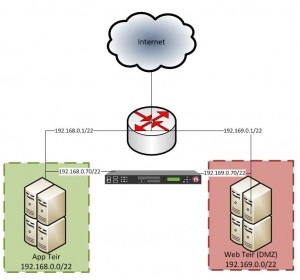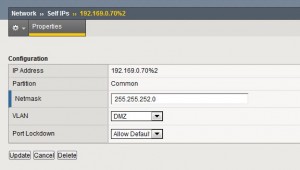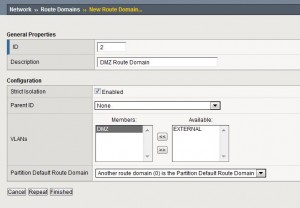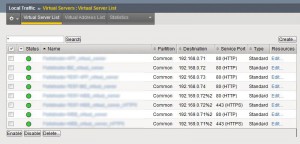I’m pretty new to the F5 NLB scene, any network load balancing I had previously done had been through the inbuilt Windows Network Load balancing (WLB) Server role. Recently I was asked to deploy a F5 configuration to an already running production environment to handle SSL Termination, Caching and (of course) Load balancing on both web and app tiers.
The existing deployment comprised of two /22 segments (Internal and DMZ networks) with a single router as the default gateway; Everything I read online told me to use a “One armed F5 Config”. This type of config “should” let me add a single physical network to one of my segments and reach both networks using a SNAT rule to adjust the origin address on the reply; But how could this work if a router was translating requests between the two networks? I discovered after many hours, it can’t…
My answer, ensure the F5 is connected to both network segments and use Route Domains to solve my routing problems. Here’s what I did:

- Utilize a free port on my F5 to connect into both networks – Most people could probably just add another VLAN to their existing network, however I don’t have the ability to control the managed network
- Establish the 2nd untagged VLAN for the 2nd connection in Step 1
- Establish a new route domain from Network -> Route Domains -> Create.
- Add a new Self-IP for the 2nd network connection on your new VLAN – Add %<routedomainID> after your IP

- Create a new Load balanced application/Virtual server and add %<routedomainID> to your VIP Address (NOTE: you will likely need to enable SNAT auto-map to the Virtual Server profile to allow return traffic via the Routedomain)
- You should “hopefully” be good to go – your application is now hopefully responding correctly and your health monitor is showing a friendly green status
This solution is merely a stop-gap until we can convert it into a routed configuration (recommended setup) – where the F5 unit will be the default gateway on both networks with something like a /29 stub network between the F5 and the router.
All in all, the F5 units are pretty blimmin powerful devices – I have a good handle on the UI but have only really scratched the surface using the BigPipe/TMSH commands. I KNOW that I’ve glossed over details, please feel free to leave a comment if you have any questions (it looks like there are many stuck Engineers on the net with the same problem)
-Patrick



might be a delayed post. but still worth doing it i believe.
I understand the necessity of placing RD in this particular setup. but I’m just trying to see if RD really need to be there because anyways if you created VIP and enable SNAT (automap) for this , eventually servers would return traffic to F5 and it again forwards to the actual client. So what is the exact need of keeping RD in this setup